Are you struggling to decide between a toaster oven vs a convection oven for your cooking needs? You’re not alone!
This comprehensive guide will walk you through the key differences, pros and cons, and factors to consider when choosing the perfect oven for your kitchen.
Let’s dive in and find the right fit for you!
Key Takeaways
- Understand the basics of toaster ovens and convection ovens for choosing the right one.
- Compare cooking performance, size/space, energy efficiency & cost between both types for informed decision making.
- Consider your needs, kitchen space & budget when selecting an oven that best suits your lifestyle.
| Feature | Toaster Oven | Convection Oven |
|---|---|---|
| Size | Smaller, compact | Larger, requires more space |
| Cooking Speed | Slower than convection ovens | Faster due to fan circulation |
| Temperature Range | Lower maximum temperature | Higher maximum temperature |
| Energy Efficiency | More energy-efficient for small meals | Less energy-efficient for small meals |
| Cooking Evenness | Less even cooking | More even cooking due to fan circulation |
| Price | Generally cheaper | Generally more expensive |
| Best for | Small meals, reheating, and toasting | Large meals, baking, and roasting |
Understanding the Basics: Toaster Ovens and Convection Ovens
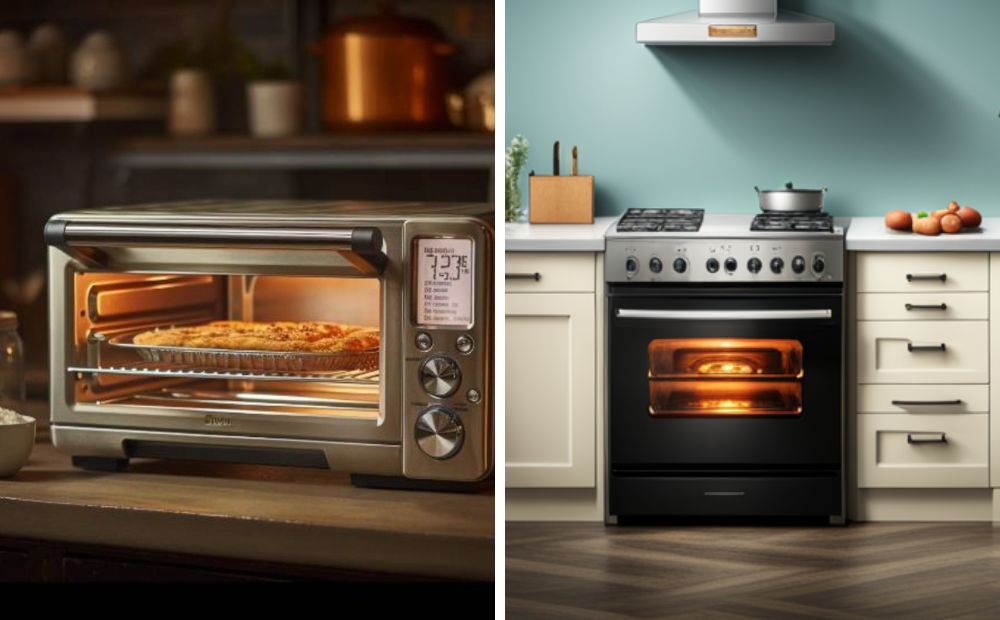
A toaster oven and convection oven
Toaster ovens and convection ovens may appear similar at first glance, but they are fundamentally different when it comes to their heating methods.
A toaster oven typically uses top and bottom heating elements to cook food, while a convection oven utilizes a fan to circulate hot air around the oven cavity for even heat distribution.
This main difference not only affects how your food is cooked, but also the versatility and efficiency of these appliances.
In recent years, there’s been a rise in popularity for convection toaster ovens, which combine the best of both worlds – the compact size of a toaster oven and the even cooking of a convection oven.
However, gaining a grasp on the basics of each type of oven is vital for determining which one suits your needs and preferences best.
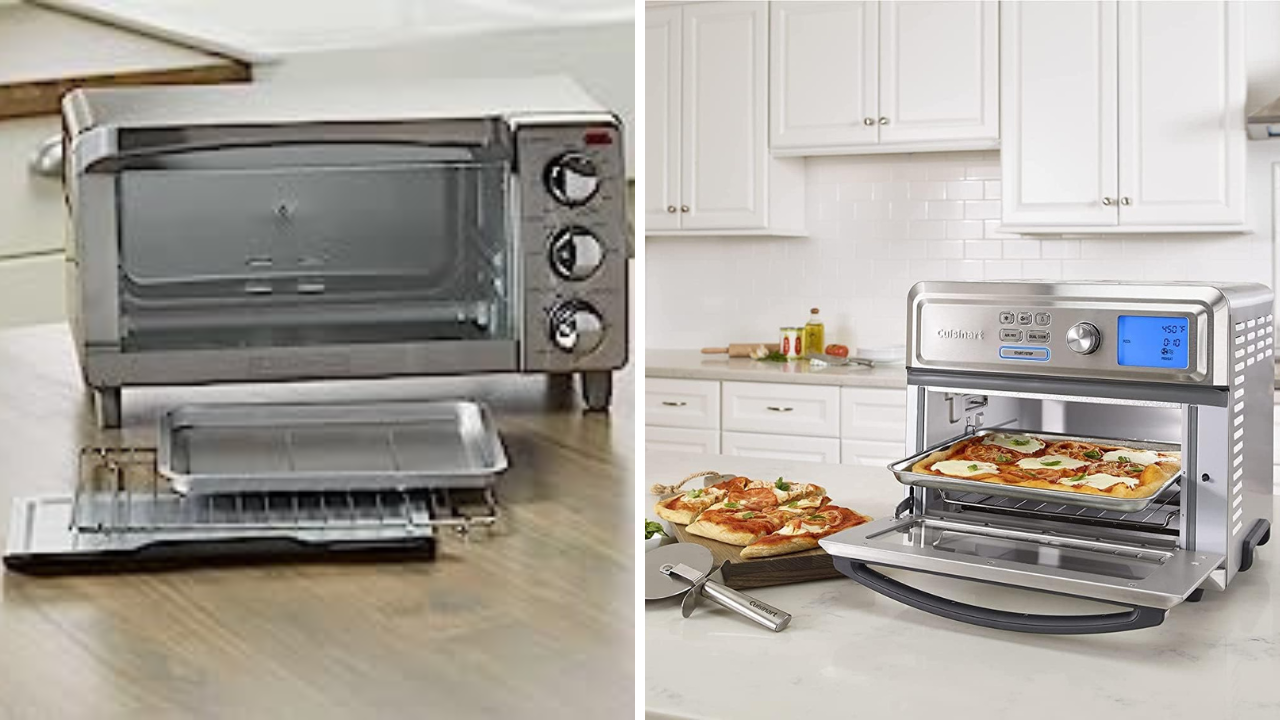
Toaster Oven Essentials
Toaster ovens are small, countertop appliances designed for simple cooking tasks such as toasting bread, reheating leftovers, and baking small portions.
They are compact and energy-efficient, making them an excellent choice for small kitchens or for single individuals with limited cooking needs.
Toaster ovens operate using top and bottom heating elements, which can provide quick and efficient heat but may not distribute it as evenly as a convection oven.
Despite their small size, many toaster oven models come with advanced features, such as adjustable temperature settings, timers, and multiple cooking functions, adding convenience and versatility to your kitchen arsenal.
Some even include accessories like removable wire racks and a removable baking pan for added functionality.
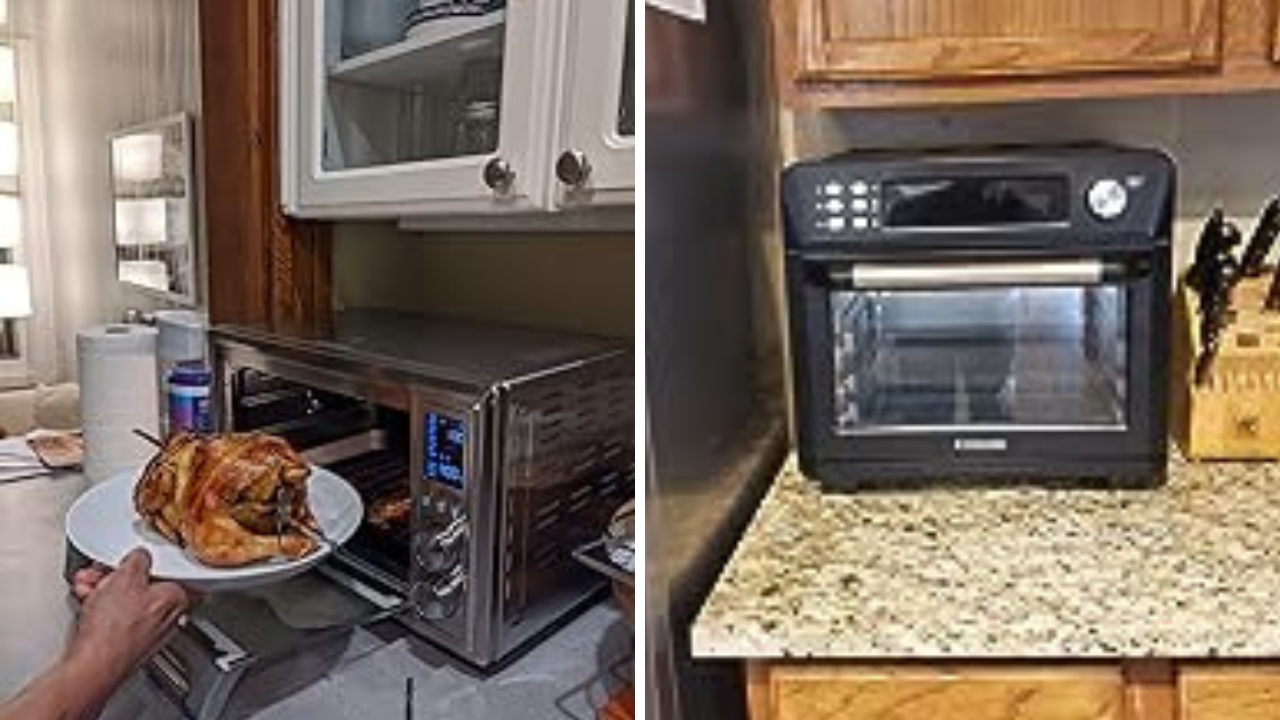
Convection Oven Essentials
Convection ovens have several advantages over toaster ovens.
- They are bigger in size and have more wattage capacity, making them more powerful.
- They feature a built-in fan that circulates hot air throughout the oven cavity, ensuring more even cooking and faster cooking times.
- This makes convection ovens suitable for a wider range of cooking tasks, including baking, roasting, and broiling larger dishes or items that require high heat.
If you frequently cook large meals or enjoy baking, a convection oven may be the better choice for you.
These ovens are typically available in full-sized, stand-alone models, as well as countertop versions for those with limited kitchen space.
The increased size and power do come with a higher price tag, but the versatility and improved cooking performance often make the investment worthwhile for avid home cooks.
Comparing Cooking Performance
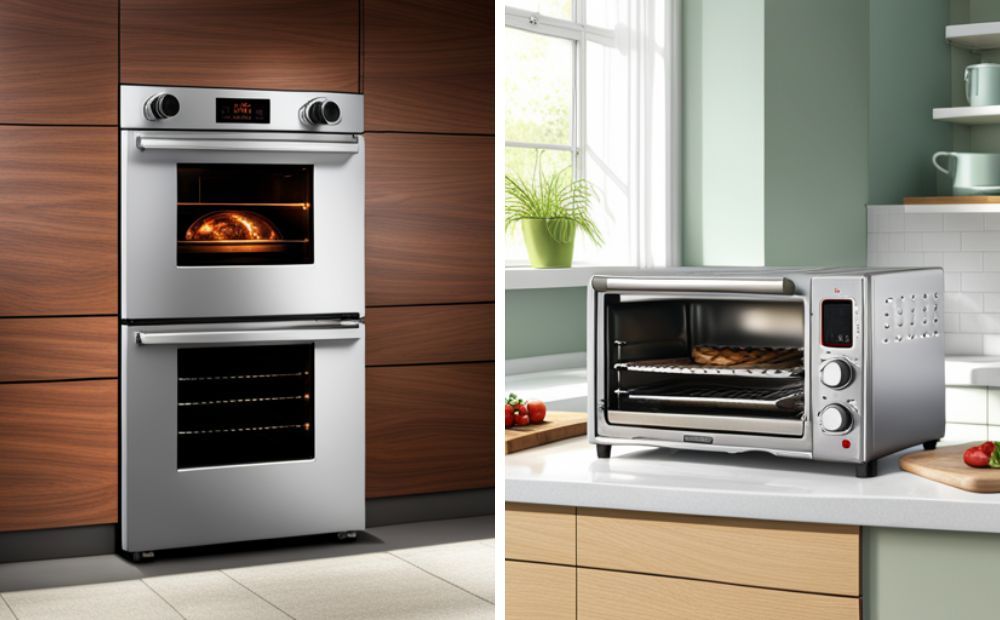
Convection oven and toaster oven
Since toaster ovens and convection ovens apply different heating methods, their cooking performance varies in terms of heat distribution, cooking time, and versatility.
Understanding these differences will help you choose the right oven for the types of dishes you want to prepare.
While toaster ovens are great for small, quick tasks like toasting bread or reheating leftovers, their top and bottom heating elements may not provide the most even heat distribution.
Convection ovens, with their circulating hot air, offer superior heat distribution, ensuring that your food cooks evenly and quickly.
This makes convection ovens better suited for larger and more complex cooking tasks.
Heat Distribution
The outcome of your dishes can be significantly affected by heat distribution, a pivotal factor in cooking performance.
Toaster ovens, which rely on top and bottom heating elements, can struggle with even heat distribution, resulting in some areas being warmer or cooler than others.
While this may be suitable for toasting bread or warming up small portions, it can be less ideal for more delicate or complex cooking tasks.
Convection ovens, on the other hand, are designed to provide consistent heat distribution throughout the oven cavity thanks to their built-in convection fan that circulates hot air.
This even heat distribution ensures that convection ovens cook food uniformly, reducing the risk of uneven cooking or hot spots.
Convection ovens are particularly useful for dishes that require precise temperature control, such as baking cakes or roasting meats.
Cooking Time
In terms of cooking time, convection ovens outperform their counterparts.
Due to their circulating hot air, convection ovens can cook food up to 30% faster than regular ovens.
This not only saves time, but also reduces energy consumption, making convection ovens an energy-efficient option for cooking.
While not as fast as convection ovens, toaster ovens still manage to prepare food more quickly than conventional ovens, usually taking 25% less time.
This makes toaster ovens perfect for smaller, time-sensitive tasks like toasting bread or reheating leftovers.
Versatility
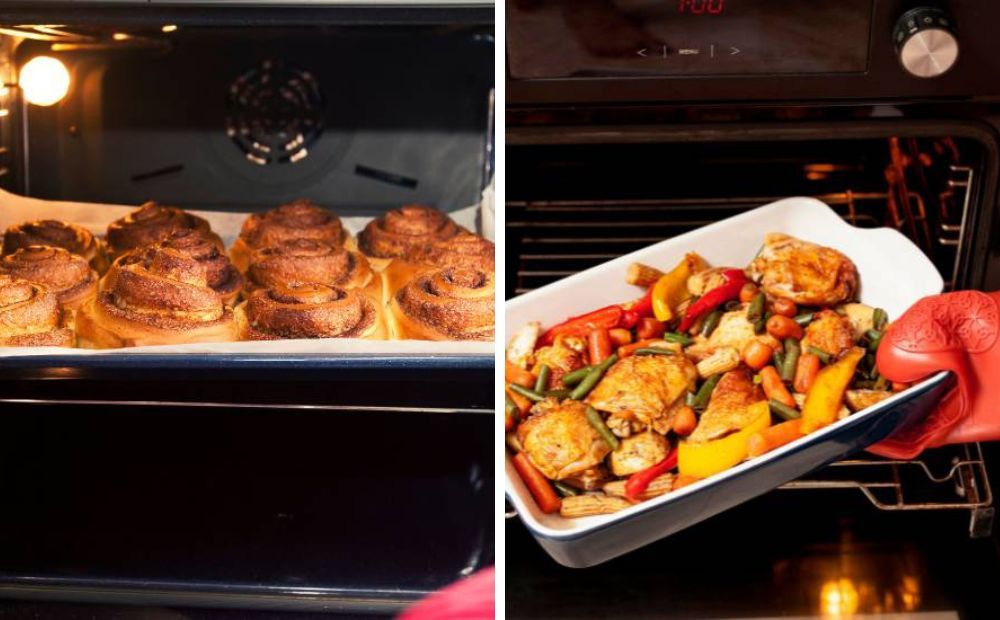
Baking and roasting in a convection ove
When it comes to versatility, convection ovens offer a broader range of cooking capabilities, making them suitable for a wider variety of dishes.
They excel at baking, roasting, and broiling tasks that require even heat distribution and high temperatures. Whether you’re baking bread, roasting a chicken, or broiling a steak, a convection oven can handle it with ease.
Toaster ovens, while not as versatile as convection ovens, still have their place in the kitchen.
They are excellent for toasting, reheating, and small-scale cooking tasks, making them a convenient addition to any kitchen, particularly for those with limited cooking needs or space constraints.
For many people, a toaster oven can serve as a valuable supplementary cooking appliance alongside a traditional oven or convection oven.
Size, Space, and Capacity Considerations
Choosing between a toaster oven and a convection oven involves considering key factors such as size, space, and capacity.
While toaster ovens are compact and space-saving, convection ovens offer larger capacities, making them suitable for different kitchen sizes and cooking needs.
If you have limited kitchen space or live alone, a toaster oven may be the more suitable option due to its compact size and ability to handle smaller cooking tasks efficiently.
On the other hand, if you have more kitchen space and frequently cook large meals or enjoy baking, a convection oven’s larger capacity and power may better serve your needs.
Toaster Oven Dimensions
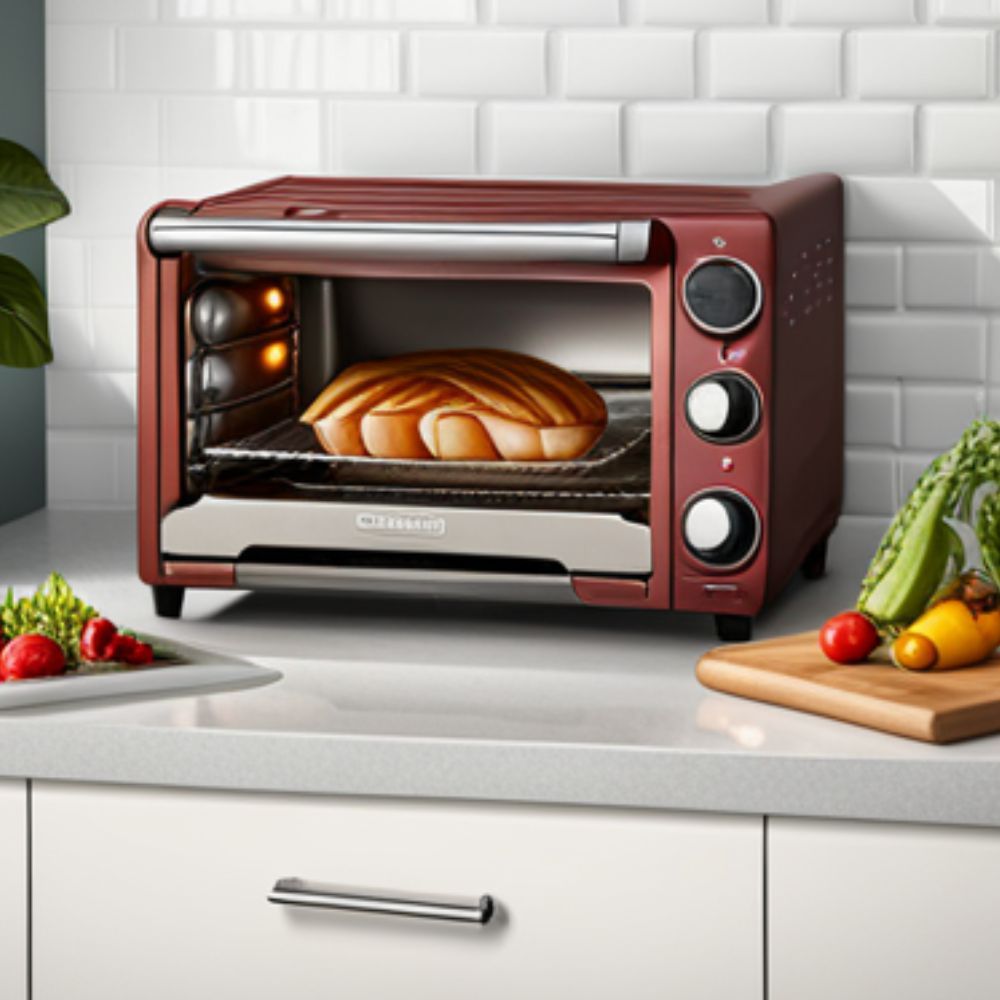
Compact toaster oven
Toaster ovens are designed to be compact and efficient with space, making them an excellent option for those with limited kitchen space or single individuals.
Their dimensions vary depending on the model, but generally, they measure approximately 17 inches in width and can be easily tucked away in a cabinet when not in use.
Larger toaster ovens, while still more compact than convection ovens, can measure up to 20 by 10 inches, providing more interior space for cooking larger portions or multiple dishes at once.
However, they still require less countertop space than a full-sized oven or convection oven.
Convection Oven Dimensions
Convection ovens, due to their larger capacities and power, require more space than toaster ovens. Full-sized, stand-alone convection ovens typically measure 30 to 36 inches wide, with a standard baking depth of 16 inches deep.
These dimensions make convection ovens better suited for larger kitchens or for those who frequently cook large meals or bake.
Countertop convection ovens, while smaller than full-sized conventional oven models, still require more space than toaster ovens but provide the same even cooking and versatility as their larger counterparts.
If you have limited kitchen space but still want the benefits of a convection oven, a countertop model may be the perfect compromise.
Energy Efficiency and Environmental Impact
The difference in energy efficiency between toaster ovens and convection ovens has implications for both your energy usage and environmental impact.
Toaster ovens generally consume less energy than convection ovens, making them a more environmentally friendly choice for your cooking needs.
However, it’s worthy of consideration that despite their higher energy usage, convection ovens, due to their hot air circulation, can prepare food faster and thus decrease overall energy consumption by minimizing cooking times.
By understanding the energy efficiency of each type of oven, you can make a more informed decision that aligns with your values and preferences.
Toaster Oven Energy Efficiency
Toaster ovens are generally considered to be energy-efficient, as they use between a third and a half less energy than conventional electric ovens for cooking.
It is estimated that a toaster oven typically uses around 1,200 to 1,800 watts of power, making them more energy-efficient and cost-effective than a gas oven or an electric oven.
By using a toaster oven for small-scale cooking tasks, you can conserve energy and reduce your electricity costs.
This makes toaster ovens a budget-friendly and environmentally responsible choice for those with limited cooking needs or smaller kitchens.
Convection Oven Energy Efficiency
Most convection ovens, while using more energy than toaster ovens, are still more energy efficient than conventional electric ovens and gas ovens.
Generally, convection ovens use between 1,500 and 2,000 watts of power.
Their energy efficiency lies in their ability to cook food faster and at lower temperatures, ultimately consuming less energy over the cooking process.
In terms of energy efficiency, it’s crucial to balance the advantages of swifter cooking times and uniform heat distribution provided by convection ovens with their increased energy usage.
For those who frequently cook large meals or bake, a convection oven may still be a more energy-efficient choice in the long run.
Cost and Value Comparison
The cost and value of toaster ovens and convection ovens each come with their own sets of pros and cons.
It is important to consider each option and determine which will be the better fit for your needs. While toaster ovens are generally more affordable, they may not offer the same versatility and cooking performance as convection ovens.
When comparing the costs and value of toaster ovens and convection ovens, it’s important to take into account your cooking requirements, kitchen space, and budget.
By understanding the differences in cost and performance, you can make a more informed decision on which oven is the best investment for you.
Toaster Oven Costs
Toaster ovens are generally cheaper than convection ovens, making them a budget-friendly option for those with limited cooking needs or kitchen space.
They can range in price from $19.99 to $299.99 or higher, depending on the brand and features. Popular retailers such as:
- Walmart
- Target
- Amazon
- Best Buy
- Lowe’s
When it comes to the oven vs debate, we offer a variety of toaster ovens, traditional ovens, and microwave oven options at various price points.
While the lower cost of toaster ovens may be appealing, it’s important to consider the limitations in versatility and cooking performance compared to convection ovens.
If your cooking needs are more extensive or you require more even heat distribution, a convection oven may be a better investment in the long run.
Convection Oven Costs
Convection ovens tend to be more expensive than toaster ovens. This is because they are bigger, more powerful and offer greater versatility.
The prices of convection ovens can range from $50 for smaller models to $500 or more for larger models, depending on size, features, and brand.
While the higher price tag may be a consideration, the improved cooking performance and versatility of convection ovens often make the investment worthwhile for avid home cooks.
To save money when purchasing a convection oven, consider the following:
- Determine which features are necessary and which can be omitted.
- Look for sales or discounts on new convection ovens.
- Consider purchasing a used convection oven, which can be an excellent way to save money without sacrificing performance.
Convection Oven vs. Toaster Oven | Your Kitchen Trends
Tips for Choosing the Right Oven for Your Needs
When choosing between a toaster oven and a convection oven, consider factors such as:
- Your cooking needs
- Kitchen space
- Budget
- Energy efficiency
If you primarily cook small meals or have limited kitchen space, a toaster oven may be the better choice.
On the other hand, if you frequently cook large meals or enjoy baking, a convection oven’s larger capacity and even heat distribution may better serve your needs.
Also, take into account the energy efficiency of each oven type and how it aligns with your values and preferences.
By carefully weighing the pros and cons of each type of oven, you can make a more informed decision and find the perfect oven to suit your lifestyle and cooking needs.
Summary
In conclusion, both toaster ovens and convection ovens have their unique advantages and disadvantages, making them suitable for different cooking tasks and kitchen spaces.
Toaster ovens are compact, energy-efficient, and budget-friendly, while convection ovens offer even heat distribution, faster cooking times, and greater versatility.
By considering factors such as cooking needs, kitchen space, budget, and energy efficiency, you can make an informed decision and choose the perfect oven for your lifestyle.
In the market for a toaster oven but want one in a color? Check out our top quality picks that could work for you!
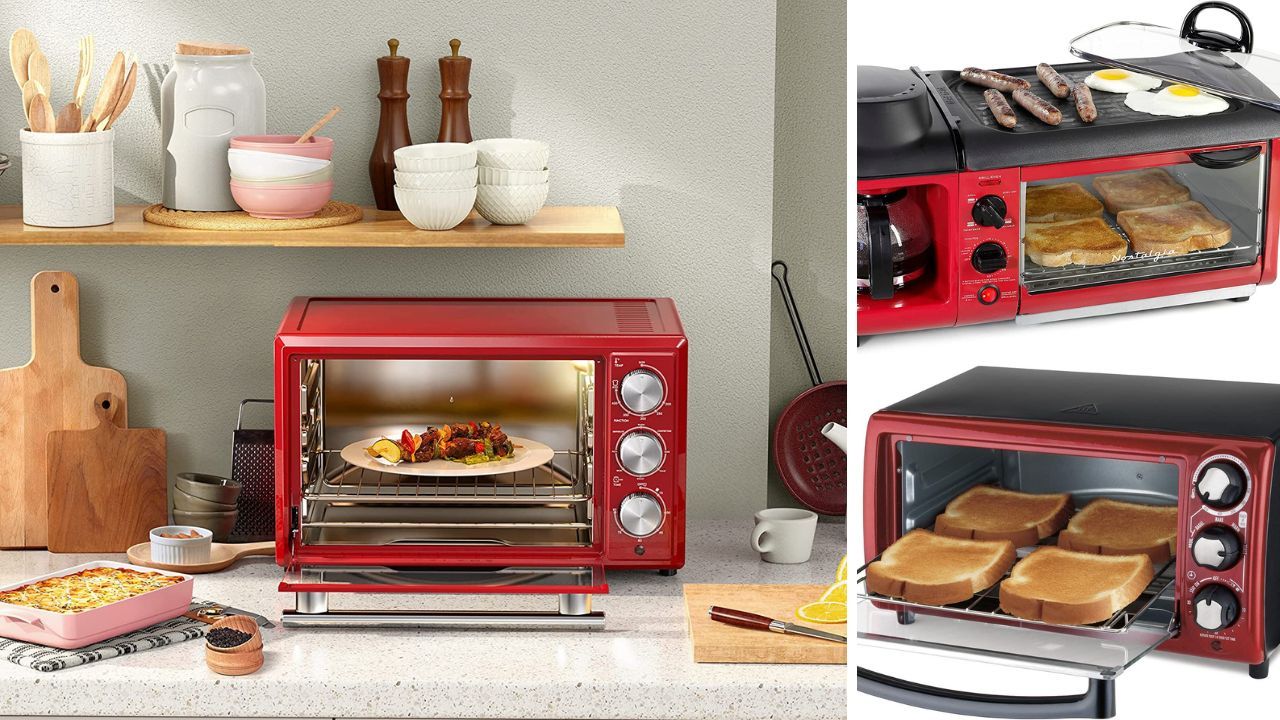
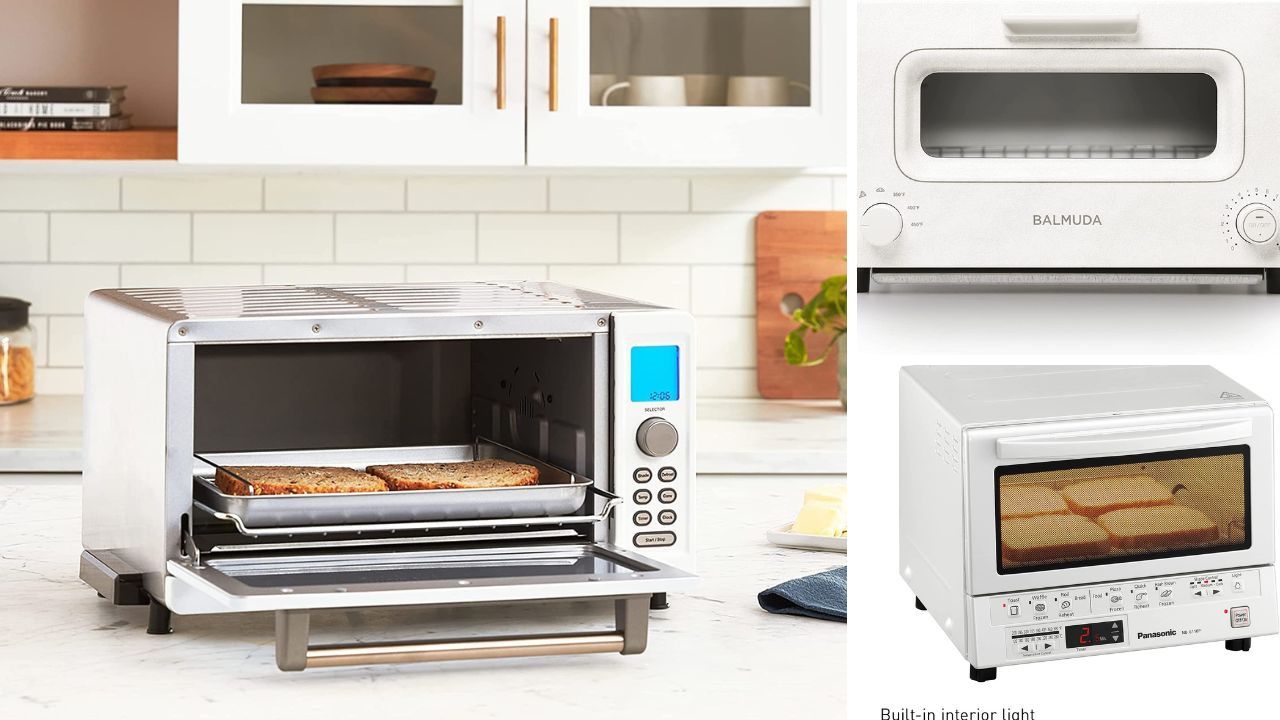
Or if you are looking for one that is designed with a sleek and modern look, then check out our top picks for digital toaster ovens.
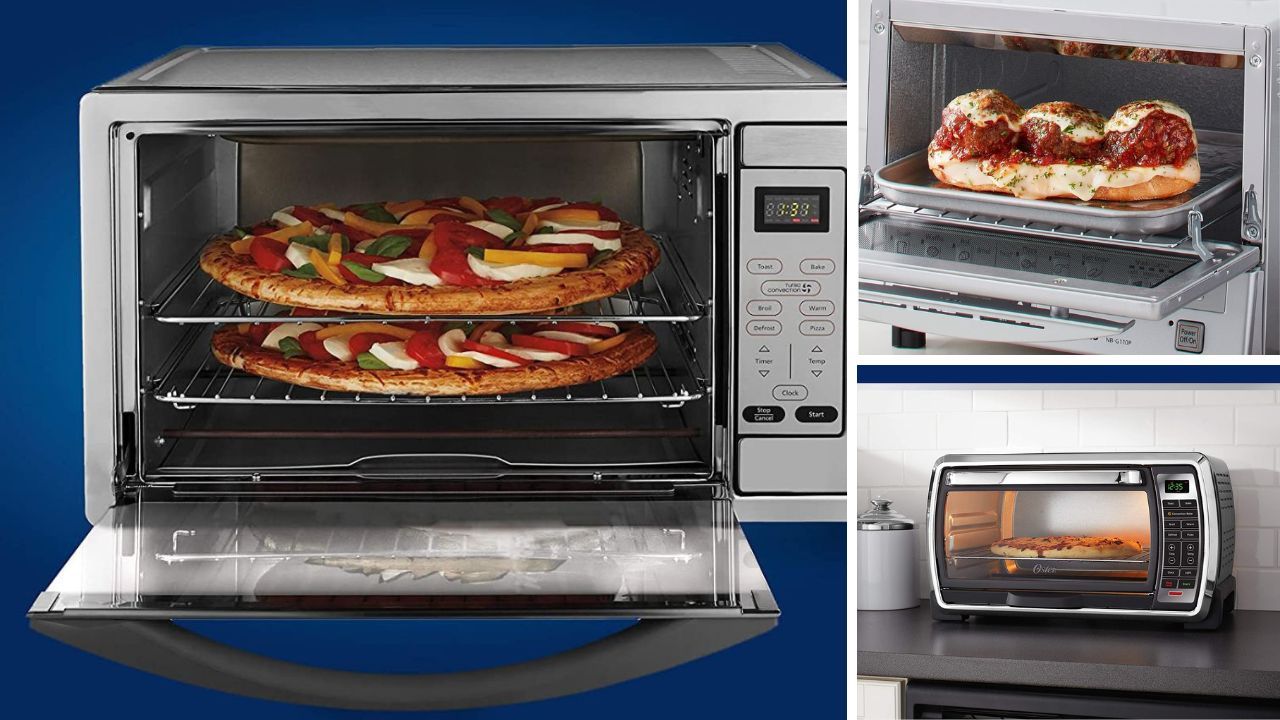

Frequently Asked Questions
Does a toaster oven cook the same as a conventional oven?
A toaster oven is essentially just a small oven with a fan that circulates heat, making the temperature inside more even and allowing food to cook quickly. As John Savoia from Kitchenwitch affirms, anything you might cook or bake in a conventional oven can be cooked in a toaster oven too.
What are the disadvantages of a toaster oven?
Toaster ovens are noisy, fairly expensive compared to a traditional toaster, and not the best choice for those just looking to toast bread slices.
What is the main difference between a toaster oven and a convection oven?
The main difference between a toaster oven and a convection oven is their heating methods - toaster ovens use top and bottom elements, while convection ovens circulate hot air for even heat distribution.
Are toaster ovens more energy-efficient than convection ovens?
Toaster ovens are more energy-efficient than convection ovens, consuming less power and using less energy for cooking tasks.
What is the advantage of a toaster oven with convection?
A convection toaster oven uses a fan to force hot air from the heating elements to circulate around the inside of the oven, promoting even cooking and shorter cook times. It also helps render fat and brown skin faster while retaining juice inside, resulting in crispier and juicier dishes.











